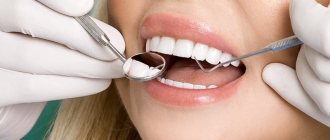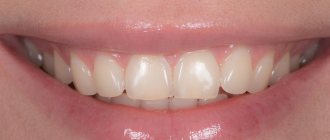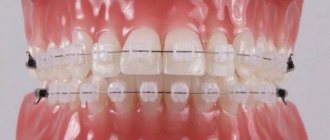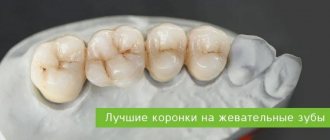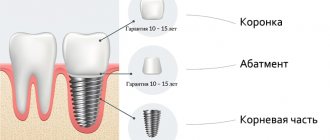To remain healthy, teeth must receive a sufficient amount of “building material” - a certain set of minerals necessary for their nutrition. Otherwise, they are affected by caries and begin to suffer from other diseases. Special dental procedures - fluoridation and saturation of teeth with calcium - help to replenish the reserves of useful minerals in case of their chronic deficiency in the enamel. It allows you to improve the appearance of your teeth, protect them from bacterial damage and premature destruction.
Fluoridation is the saturation of tooth enamel with fluoride, as well as the main minerals that form bone tissue: calcium, magnesium and others.
During the procedure, harmful bacterial flora is destroyed, fluoride ions penetrate the enamel structure. They restore and strengthen it from the inside. This provides effective prevention and treatment of caries at the stain stage, and also helps reduce tooth sensitivity.
When is remineralization indicated?
Proper nutrition and oral hygiene are very important, but not always sufficient conditions for maintaining dental health. In order for prevention to be complete, remotherapy-remineralization should be carried out regularly. This procedure gives good results in restoring enamel after whitening. It is used as a preparatory stage before bleaching, but after hygiene. Remotherapy can be clinical or home (as prescribed by a doctor).
The procedure is also indicated for:
- large-scale anti-caries therapy;
- hypersensitivity;
- after removing braces;
- pregnancy.
How does the fluoridation procedure work for teeth enamel?
The manipulation itself is completely painless and goes away quite quickly, which is why fluoridation of tooth enamel is very popular in pediatric dentistry.
The procedure for deep fluoridation of a baby tooth is carried out by a dentist in a specialized clinic and consists of two stages. At the first stage, it is necessary to clean and prepare the mouth and teeth; at the second, the teeth are directly coated with a fluoride-containing agent.
The procedure for preparing the oral cavity immediately before the fluoridation procedure is carried out by a dentist. During the process, the teeth are thoroughly cleaned of plaque, the tooth enamel is dried, and then coated with a special substance. This is followed by deep fluoridation of the tooth. Using cotton swabs pre-moistened in mineral solutions, the surface of the teeth is treated. As a result, fluorides and calcium preparations are able to penetrate deep and hard-to-reach layers of tooth enamel. Deep fluoridation is much more effective than simple fluoridation, since it saturates the teeth with the necessary substances several times better.
Regular dental fluoridation can solve many problems with tooth enamel in both children and adult patients. Numerous scientific works devoted to this topic prove that high-quality fluoridation of tooth enamel can significantly reduce the risk of caries in patients, regardless of age and initial condition of tooth enamel.
Types of fluoridation
Simple
A fairly effective way to prevent caries. A special composition is applied to the teeth in the form of a thin film, which is not felt at all and lasts up to 6 months.
Glubokoe
The method is used when the integrity of the enamel is damaged. It involves the use of compounds containing, in addition to fluorine, calcium and other minerals. Such compositions are built into the structure of tooth enamel. The effect of the procedure lasts for a year.
Before the procedure, the patient visits a hygienist. The specialist carries out a comprehensive cleaning of teeth, freeing them from bacterial plaque. This will allow the mineral ions to freely penetrate the enamel and do their work.
The procedure is carried out in three stages.
- Drying. The composition is applied to teeth dried from saliva.
- Application. The medicine is evenly distributed over the surface of the teeth, left for 5–7 minutes, after which the teeth are dried again.
- Finishing processing. To consolidate the effect, a concentrated mineral composition is applied to the teeth.
Types of dental fluoridation
The beneficial effects of fluoride on tooth enamel are due to a number of reasons. First of all, fluorides ensure remineralization of tooth enamel and stop the proliferation of pathogenic bacteria that can trigger the development of caries.
There are two approaches to fluoridation of teeth: simple and deep. With simple fluoridation, either mouthguards filled with fluoride-containing preparations or a special varnish covering the teeth are used.
The deep fluoridation technique involves the use of specialized enamel-sealing preparations. The main advantage of this method compared to simple fluoridation is that deep fluoridation allows you to create fluoride deposits on the surface of the enamel, thereby prolonging the action of fluoride.
Fluoridation of baby teeth
Failure to take your child to the dentist will lead to problems with permanent teeth. An important component of the prevention and treatment of caries in children is enamel fluoridation. The procedure can be performed for the first time at the age of 3 years. It does not cause a negative reaction in children and helps prevent the development of dental phobia in the future.
Important! The procedure is prescribed to children only after undergoing tests - excess fluoride can adversely affect the child’s health.
Fluoridation of teeth: advantages and disadvantages
There are different views on the advisability of using fluoridation to strengthen teeth.
The health of teeth is largely determined by the condition of the enamel coating; its strength is ensured by calcium and fluoride. If there is a lack of any of these elements in the body, the enamel may become thinner and become more prominent - this process is called demineralization. In such cases, fluoridation is prescribed. It helps make teeth more resistant to acid that occurs when saliva breaks down carbohydrates. However, since this coating cannot last long, it is recommended to repeat the procedure once a year.
Sodium fluoride is a popular component in medicated toothpastes. Such pastes reduce the ability of acids to negatively affect tooth enamel and minimize the damage previously caused to tooth enamel by acids.
Despite all its advantages, fluorine is a toxic substance and more dangerous to the human body than lead.
One tube of toothpaste contains a fairly dangerous amount of fluoride - if you eat a tube of toothpaste at once, you can get poisoned. In the long term, fluoride accumulates in teeth and bones, which can lead to the development of diseases such as fluorosis and osteosclerosis. Symptoms of these disorders include weight loss, brittle bones, stiff joints and ligaments, and anemia, or anemia. Fluoridation should be used with caution in patients with renal failure or diabetes mellitus.
Indications and harm
The fluoridation procedure is indicated in the following cases:
- at the first signs of initial caries;
- increased sensitivity, pain;
- lack of fluoride in food and drink;
- protection of tissues when wearing orthodontic structures, braces;
- extending the service life of already installed fillings;
- for prevention.
The procedure is not recommended in the following situations:
- the fluoride content in the diet is high, it is necessary to control the amount of the element, excluding fluorosis;
- individual intolerance to the components of strengthening compositions;
- the presence of medium, deep caries;
- penetration of infectious processes into dentin.
Stages of deep fluoridation
The whole process looks like this step by step:
- Professional teeth cleaning.
- Mandatory drying of the surface of the teeth.
- Application of a composition containing fluorides with a special brush.
- Repeated drying, naturally (5-7 min.).
- Re-treatment of enamel with a preparation based on calcium hydroxide.
After the procedure, the dentist usually recommends refraining from eating for one and a half to two hours, and also completely avoid drinking carbonated drinks, which provoke demineralization of tooth enamel.
Fluoridation of teeth is an effective method of preventing caries in children and adults
Fluoridation of teeth - how it works
The most common dental disease is caries.
Tooth destruction begins with the dissolution of the mineral substances that make up the tooth enamel, followed by the destruction of hard tissues and the formation of a carious cavity. The preventive anti-caries effect of fluoride lies in the fact that its additional introduction into the tooth enamel (fluoridation of teeth) leads to the formation of a stable form of fluorapatite (a component of dental tissue) in the structure of the tooth enamel, which: Increases the resistance of enamel to the corrosive effects of acids. ? Suppresses the activity of bacteria, thereby reducing the formation of acids.
Children are more susceptible to caries. In baby and newly erupted teeth, the enamel has not yet fully matured; it is more susceptible to the effects of acids - waste products of oral microorganisms. Insufficient oral hygiene leads to an uncontrolled increase in the number of microorganisms (bacteria) in dental plaque, which, in turn, further reduces the resistance of tooth enamel to the effects of acids released during the life of bacteria.
Doctors at Apollonia Dentistry support the official position of the Dental Association of Russia (StAR) that fluoride-containing products must be used to prevent caries. Link to StAR article >> ?Fluoride prophylaxis is the most effective available and clinically proven method of preventing the development of caries in adults and children. ?Regular use of fluoride in optimal quantities is safe, as confirmed by the results of numerous clinical trials. ?Due to the widespread low content of ionized fluorine in drinking water in the Kemerovo region (0.2 mg/l - 0.4 mg/l, the norm for our region is 1 mg/l), it is necessary to carry out fluoride prophylaxis, including in dental settings office.
Indications and contraindications for the “Dental fluoridation” procedure:
Indications 1. Prevention of caries in children and adults in areas with fluoride content in drinking water below optimal for a given climatic zone; 2. Treatment of early forms of dental caries; 3. Reducing tooth sensitivity; 4. Restoration of the enamel surface after professional removal of dental plaque (professional cleaning). Contraindications 1. Increased fluoride content in drinking water; 2. The patient has dental fluorosis; 3. Allergic reactions to fluorides.
Methods of fluoridation of teeth in Apollonia dentistry
Preventive fluoridation of teeth using APF gel
The gel contains 1.23% NaF and citric acid (acid buffer). Due to the acidity of the drug, fluoride ions actively penetrate the enamel and are built into its structure within 3-4 minutes.
At Apollonia Dentistry, doctors use Sorbet APF gel. With regular application, the gel increases the hardness of the enamel by 10 times, and also significantly increases the service life of the fillings. Recommended for children.
Methodology of the procedure:
Before the procedure, the surface of the teeth is thoroughly cleaned of plaque, isolated from saliva using cotton swabs and a saliva ejector, and dried. Fluoride-containing gel is applied to the surface of the teeth in standard trays. Application duration is 4 minutes. After the procedure is completed, excess gel is removed from the mouth, and then the patient must refrain from eating and drinking for 2 hours. It is recommended to carry out this procedure on the surface of all teeth at least twice a year.
Fluoridation with varnish
Fluoride-containing varnish is used to prolong the period of fluoride exposure to enamel. It forms a film adjacent to the enamel that remains on the teeth for several hours, and in fissures, crevices and microspaces for several days and even weeks.
Apollonia Dentistry uses Colgate Duraphat varnish. A single application of varnish increases the fluoride content in enamel by 77% and protects teeth from caries for several months.
Methodology of the procedure:
The varnish is applied to a cleaned and dry enamel surface using a brush and dried for the time specified by the manufacturer. After the procedure, the patient should not brush his teeth or eat very solid foods for 12-24 hours. The frequency of use of fluoride-containing varnish is determined individually (2 times a year or more), depending on the condition of the hard tissues of the teeth and the degree of risk of caries in the patient.
Deep fluoridation of teeth
Deep fluoridation refers to the chemical formation of calcium fluoride with a very small particle size (50 angstroms). This process occurs as a result of sequential wetting of the enamel with a weakly acidic solution of magnesium fluoride silicate and subsequent blotting with an alkaline suspension of copper-calcium hydroxide. The formed calcium fluoride crystals penetrate deep into the pores of the enamel, protected from washing out. They release fluoride ions in high concentrations for a long time (more than 1 year), promoting enamel remineralization.
Doctors at Apollonia Dentistry use the brilliantly proven drug “Gluflutored” for deep fluoridation. As a result of sequential application of liquid and suspension, enamel microcracks are sealed. The resulting substance is a high-molecular polymer that provides effective protection of tooth tissue from acids.
Methodology of the procedure.
Cleaned and dried tooth surfaces are thoroughly moistened with liquid No. 1 for 10 s. After 30 s, liquid No. 2 is applied to all surfaces of the teeth in a thin layer for 10 s. After 30 seconds, the patient can rinse his mouth. To prevent dental caries – 1 procedure 1-2 times a year. To increase the caries resistance of enamel in the presence of braces, apply twice with an interval of 1-2 weeks, then 1 procedure every 4-6 months.
Schedule a professional cleaning and fluoridation appointment today! Make an appointmentContacts
Fluoridation methods
There are two ways to carry out this preventive procedure. In both cases, the preparatory stage is professional teeth cleaning - this is a necessary and mandatory condition. So, fluoridation happens:
1. Simple. The procedure includes the following manipulations:
- coating of tooth enamel with fluoride varnish;
- installation of individual trays filled with a special gel.
In both cases, the time required for prophylaxis does not exceed 10-15 minutes.
2. Deep. It involves layer-by-layer application of two drugs, which provides a longer-term effect. This method requires slightly more time than in the first case.
Stages of implementation
Special professional solutions containing fluoride are applied to the surface of the tooth enamel. Due to this, the dental tissue is gradually saturated with fluoride compounds. Fluoridation of teeth in children has a number of specific features. This is due to the fact that children most often prefer to eat sweets. And therefore, personal oral hygiene is not always observed correctly.
Fluoridation of baby teeth is carried out using a special technology. Unlike adults, fluoride compounds are applied to each tooth separately for children under 3 years of age.
This technology makes it possible to achieve a better effect, since children are most often exposed to carious flora. The frequency with which it is recommended to strengthen the enamel in this way is once a year.


